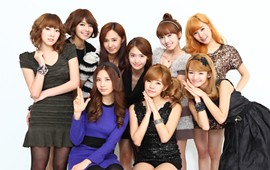
With 2011 already off to a fast start, the Korean music industry has been gearing up for plans of a new ’smart idol’ development to the Hallyu wave, in what is now known as idol economics.
The Korean idol industry has been recognized as being top tier in dancing, singing, and looks, and the training system has received acknowledgment from international industries as well. An extensive amount of investments are made into trainees, with top companies like SM Entertainment investing millions into producing their line of idols. The idol industry itself has been reported to be making billions a year.
The fruits of their effort can be seen in Japan, the center of the Hallyu wave. Korean artists such asSNSD, KARA, 4minute, and 2PM are plastered near the entrances of record stores, and three to four groups of Japanese youth can be seen browsing the Korean section at any given moment.
Yoshida Jun, the Shibuya branch manager of Tower Records, revealed, “The sales of Korean idol group albums have risen 40% in 2010 compared to sales of 2009. With the debut of Korean girl groups such as SNSD, KARA, and 4minute, along with the rising popularity of FT Island, the teens to 20s consumer base has been created.”
The power of Korean idol stars has developed the Hallyu market, as well as change ‘the economics of Hallyu.’ Samsung Economics Research Institute (SERI) once called BoA a ’small walking enterprise’ for her achievements in the Japanese market, and claimed that she was worth billions.
Idol singers who go through extensive training to survive in a competitive environment emerge with excellent talent in not only dancing and singing, but acting and variety show skills that exceed the economic worth of the former Hallyu stars.
Jung Taesu of SERI attributed three reasons to the leading of the new Hallyu wave by idol stars: their ability to ‘melt and join together a variety of different cultures,’ an idol training system that creates only the best, and the use of social media and global networking.

Out of the three, the most acknowledged is the idol training system that features both the fierce competition in auditions and years of physical training.
But how much does it cost to raise one idol? According to the majority of industry representatives, agencies spend about $20,000 USD to $40,000 USD per idol per year. The amount pays for their food, transportation, singing, vocal, acting, and foreign language training. This figure does not include the cost of health, figure management, beauty, and plastic surgery.
Each agency houses over 20 trainees, and top agencies such as SM, YG, and JYP spend upwards of millions a year in just the investments made on their trainees alone.
Using five years of training as an example, to debut one girl group member in that time requires a minimum investment of $150,000 USD. That means in order to produce a nine-member girl group likeSNSD, agencies must invest a minimum of $1,300,000 USD.
That figure does not include the expenses for their dorm, transportation, manager, outfit costs, album productions, promotion, and marketing. To include all of such factors would require a minimum of $2,000,000 USD in their creation alone.
However, the years of investing they did in their idol groups are repaid in the form of hundreds of millions of dollars once the group makes a successful debut overseas. Once the group begins making sales in not only albums and CF, but various merchandising products in Japan, China, and South East Asia, an idol group can easily bring in a billion a year.
KARA and SNSD, who entered the Japanese market late last year, both made over $30 million in album sales alone. Although TVXQ halted their activities due to their lawsuit, they recorded over $130 million USD in album sales in Japan last year.
2PM, B2ST, SHINee, and MBLAQ, who are all currently preparing to enter the Japanese market, are expected to achieve similar results.

Japanese boy group Arashi ranked first in album sales last year by bringing in $237 million USD, and if this is considered the best an artist can achieve in the Japanese market, representatives have interpreted it to mean that Hallyu artists can soon surpass $200 million USD in sales. With the addition of digital sales and album sales made in China and other South East Asian countries, Hallyu artists can easily achieve over $300 million to $400 million USD in sales.
According to an industry representative, the most one team can make through an Asian tour is $50 million USD a year. The addition of photobooks, memorabilia, t-shirts, and cosmetic sales, along with movie and drama appearances round out the total to a billion a year, when all it took was an initial $2 million USD investment.
A representative of SM Japan revealed, “Although some Korean merchandise are being sold illegally in Japan, they have recorded high sales. It’s difficult to gouge the exact amount, but it seems a formidable market is being created. Japanese fans want to physically purchase merchandise regarding their favorite stars more so than their Korean counterparts, which further raises the sales.”
Such power has transcended the music industry and has greatly influenced culture and tourism as well. According to the Korea Tourism Organization, international tourists seeking Hallyu star fanmeetings and other K-pop events doubled in the previous year, amounting to over 34,000 people.
The industry is also paying closer attention to the teens through 20s consumer base, as they’ve developed past merely enjoying idol dancing and outfits to loving ‘everything about Korea.’ Due to such effects, global brands such as LG and Samsung have begun using the Hallyu wave by featuring Korean idol groups in their advertisements.













No comments:
Post a Comment